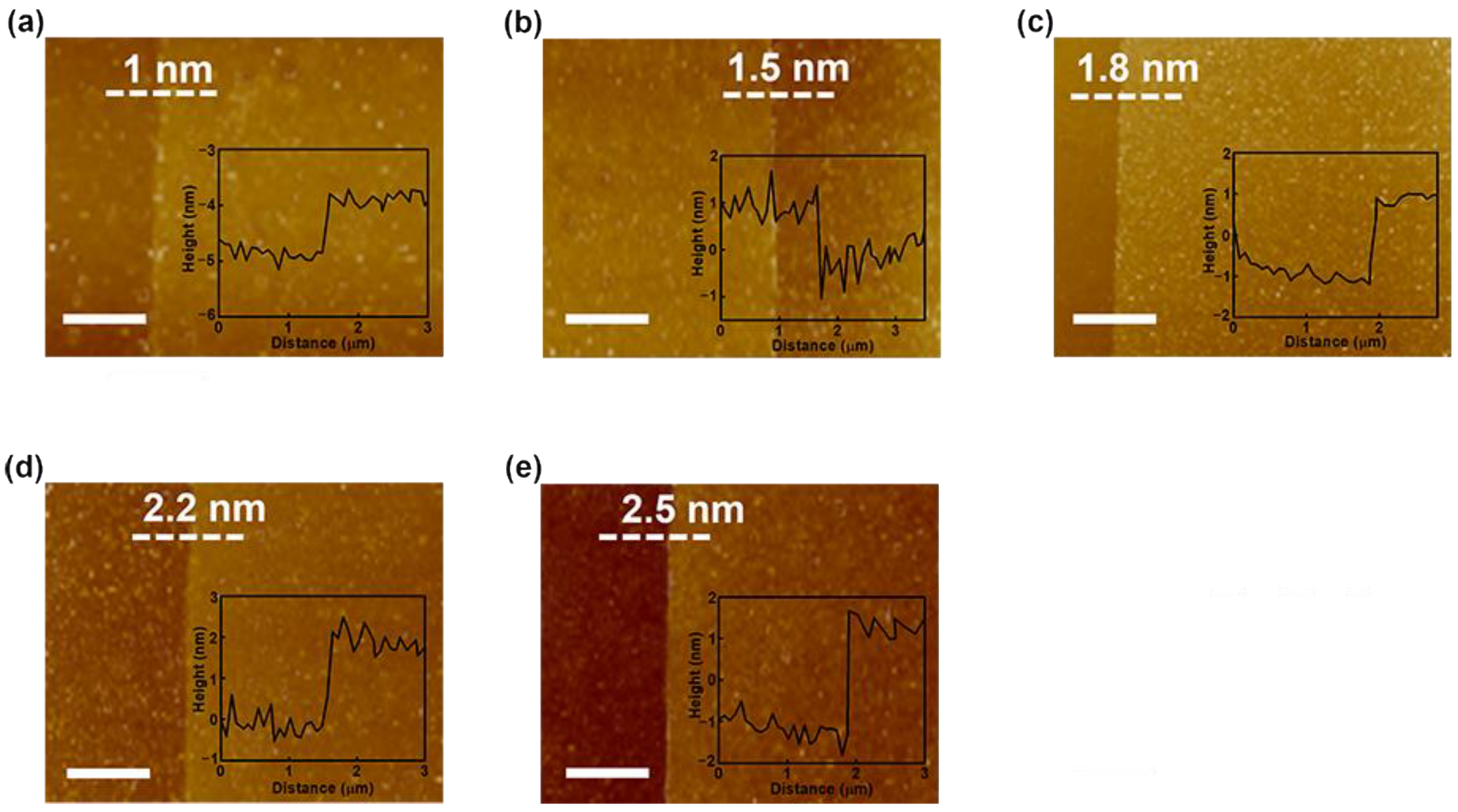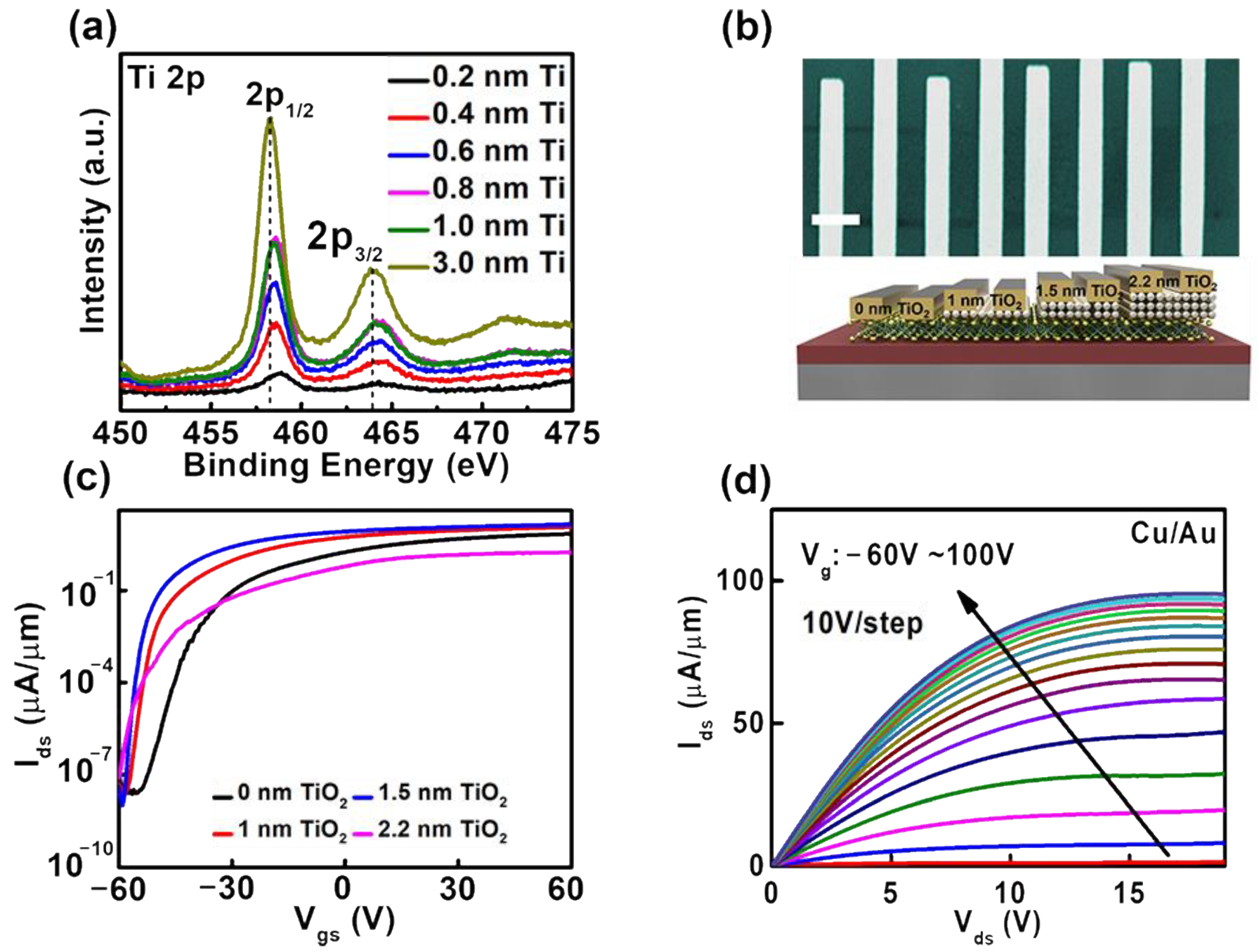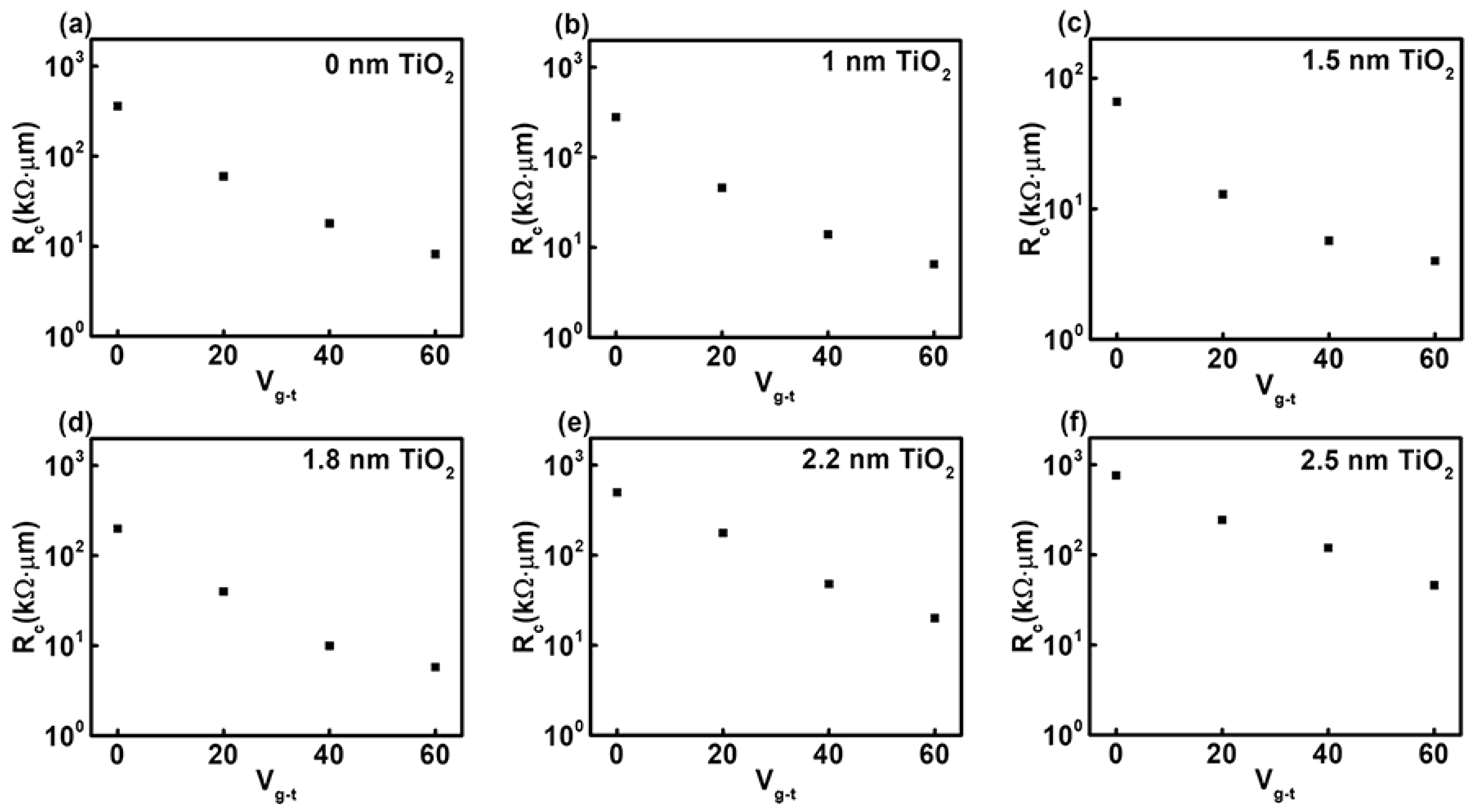MoS2 Transistors with Low Schottky Barrier Contact by Optimizing the Interfacial Layer Thickness
Abstract
:1. Introduction
2. Experimental Samples and Analysis Techniques
3. Results and Discussion
4. Conclusions
Author Contributions
Funding
Institutional Review Board Statement
Informed Consent Statement
Data Availability Statement
Conflicts of Interest
References
- Zhang, X.; Li, Y.; Mu, W.; Bai, W.; Sun, X.; Zhao, M.; Zhang, Z.; Shan, F.; Yang, Z. Advanced tape-exfoliated method for preparing large-area 2D monolayers: A review. 2D Mater. 2021, 8, 032002. [Google Scholar] [CrossRef]
- Hwangbo, S.; Hu, L.; Hoang, A.T.; Choi, J.Y.; Ahn, J.-H. Wafer-scale monolithic integration of full-colour micro-LED display using MoS2 transistor. Nat. Nanotechnol. 2022, 17, 500–506. [Google Scholar] [CrossRef] [PubMed]
- Zhou, Y.; Wang, Y.; Zhuge, F.; Guo, J.; Ma, S.; Wang, J.; Tang, Z.; Li, Y.; Miao, X.; He, Y.; et al. A Reconfigurable Two-WSe2-Transistor Synaptic Cell for Reinforcement Learning. Adv. Mater. 2022, 2107754. [Google Scholar] [CrossRef]
- Tang, Y.; Huang, C.-H.; Nomura, K. Vacuum-Free Liquid-Metal-Printed 2D Indium-Tin Oxide Thin-Film Transistor for Oxide Inverters. ACS Nano 2022, 16, 3280–3289. [Google Scholar] [CrossRef]
- Lee, D.; Choi, Y.; Kim, J.; Kim, J. Recessed-Channel WSe2 Field-Effect Transistor via Self-Terminated Doping and Layer-by-Layer Etching. ACS Nano 2022, 16, 8484–8492. [Google Scholar] [CrossRef] [PubMed]
- Wu, H.; Cui, Y.; Xu, J.; Yan, Z.; Xie, Z.; Hu, Y.; Zhu, S. Multifunctional Half-Floating-Gate Field-Effect Transistor Based on MoS2-BN-Graphene van der Waals Heterostructures. Nano Lett. 2022, 22, 2328–2333. [Google Scholar] [CrossRef]
- Cheng, J.; Wang, C.; Zou, X.; Liao, L. Recent Advances in Optoelectronic Devices Based on 2D Materials and Their Heterostructures. Adv. Opt. Mater. 2018, 7, 1800441. [Google Scholar] [CrossRef]
- Geim, A.K.; Novoselov, K.S. The rise of graphene. Nat. Mater. 2007, 6, 183–191. [Google Scholar] [CrossRef]
- Novoselov, K.S.; Geim, A.K.; Morozov, S.V.; Jiang, D.; Zhang, Y.; Dubonos, S.V.; Grigorieva, I.V.; Firsov, A.A. Electric Field Effect in Atomically Thin Carbon Films. Science 2004, 306, 666–669. [Google Scholar] [CrossRef]
- Mak, K.F.; Lee, C.; Hone, J.; Shan, J.; Heinz, T.F. Atomically Thin MoS2: A New Direct-Gap Semiconductor. Phys. Rev. Lett. 2010, 105, 136805. [Google Scholar] [CrossRef] [Green Version]
- Kuc, A.; Zibouche, N.; Heine, T. Influence of quantum confinement on the electronic structure of the transition metal sulfide TS2. Phys. Rev. B 2011, 83, 245213. [Google Scholar] [CrossRef]
- Yu, Z.; Pan, Y.; Shen, Y.; Wang, Z.; Ong, Z.-Y.; Xu, T.; Xin, R.; Pan, L.; Wang, B.; Sun, L.; et al. Towards intrinsic charge transport in monolayer molybdenum disulfide by defect and interface engineering. Nat. Commun. 2014, 5, 5290. [Google Scholar] [CrossRef] [PubMed]
- Yoon, Y.; Ganapathi, K.; Salahuddin, S. How Good Can Monolayer MoS2 Transistors Be? Nano Lett. 2011, 11, 3768–3773. [Google Scholar] [CrossRef]
- Popov, I.; Seifert, G.; Tomanek, D. Designing Electrical Contacts to MoS2 Monolayers: A Computational Study. Phys. Rev. Lett. 2012, 108, 156802. [Google Scholar] [CrossRef] [PubMed]
- Du, H.; Kim, T.; Shin, S.; Kim, D.; Kim, H.; Sung, J.H.; Lee, M.J.; Seo, D.H.; Lee, S.K.; Jo, M.-H.; et al. Schottky barrier contrasts in single and bi-layer graphene contacts for MoS2 field-effect transistors. Appl. Phys. Lett. 2015, 107, 233106. [Google Scholar] [CrossRef]
- Du, Y.; Liu, H.; Neal, A.T.; Si, M.; Ye, P.D. Molecular Doping of Multilayer MoS2 Field-Effect Transistors: Reduction in Sheet and Contact Resistances. IEEE Electron. Device Lett. 2013, 34, 1328–1330. [Google Scholar] [CrossRef]
- Das, S.; Chen, H.-Y.; Penumatcha, A.V.; Appenzeller, J. High Performance Multilayer MoS2 Transistors with Scandium Contacts. Nano Lett. 2013, 13, 100–105. [Google Scholar] [CrossRef]
- Lee, S.; Tang, A.; Aloni, S.; Wong, H.-S.P. Statistical Study on the Schottky Barrier Reduction of Tunneling Contacts to CVD Synthesized MoS2. Nano Lett. 2016, 16, 276–281. [Google Scholar] [CrossRef]
- Wang, J.; Yao, Q.; Huang, C.-W.; Zou, X.; Liao, L.; Chen, S.; Fan, Z.; Zhang, K.; Wu, W.; Xiao, X.; et al. High Mobility MoS2 Transistor with Low Schottky Barrier Contact by Using Atomic Thick h-BN as a Tunneling Layer. Adv. Mater. 2016, 28, 8302–8308. [Google Scholar] [CrossRef]
- Kim, Y.; Park, W.; Yang, J.H.; Cho, C.; Lee, S.K.; Lee, B.H. Reduction of low-frequency noise in multilayer MoS2 FETs using a Fermi-level depinning layer. Phys. Status Solidi RRL 2016, 10, 634–638. [Google Scholar] [CrossRef]
- Simsek, E.B. Solvothermal synthesized boron doped TiO2 catalysts: Photocatalytic degradation of endocrine disrupting compounds and pharmaceuticals under visible light irradiation. Appl. Catal. B Environ. 2017, 200, 309–322. [Google Scholar] [CrossRef]
- Shi, Z.; Yang, P.; Tao, F.; Zhou, R. New insight into the structure of CeO2-TiO2 mixed oxides and their excellent catalytic performances for 1,2-dichloroethane oxidation. Chem. Eng. J. 2016, 295, 99–108. [Google Scholar] [CrossRef]
- Heine, V. Theory of Surface States. Phys. Rev. 1965, 138, A1689–A1696. [Google Scholar] [CrossRef]
- Tersoff, J. Schottky Barrier Heights and the Continuum of Gap States. Phys. Rev. Lett. 1984, 52, 465. [Google Scholar] [CrossRef]
- Hu, J.; Saraswat, K.C.; Wong Philip, H.-S. Metal/III-V effective barrier height tuning using atomic layer deposition of high-κ/high-κ bilayer interfaces. Appl. Phys. Lett. 2011, 99, 092107. [Google Scholar] [CrossRef]
- Hu, J.; Saraswat, K.C.; Wong Philip, H.-S. Metal/III-V Schottky barrier height tuning for the design of nonalloyed III-V field-effect transistor source/drain contacts. J. Appl. Phys. 2010, 107, 063712. [Google Scholar] [CrossRef]
- Wang, W.; Liu, Y.; Tang, L.; Jin, Y.; Zhao, T.; Xiu, F. Controllable Schottky Barriers between MoS2 and Permalloy. Sci. Rep. 2014, 4, 6928. [Google Scholar] [CrossRef]
- Farmanbar, M.; Brocks, G. Controlling the Schottky barrier at MoS2/metal contacts by inserting a BN monolayer. Phys. Rev. B 2015, 91, 161304. [Google Scholar] [CrossRef]
- Anugrah, Y.; Robbins, M.C.; Crowell, P.A.; Koester, S.J. Determination of the Schottky barrier height of ferromagnetic contacts to few-layer phosphorene. Appl. Phys. Lett. 2015, 106, 103108. [Google Scholar] [CrossRef]
- Allain, A.; Kang, J.; Banerjee, K.; Kis, A. Electrical contacts to two-dimensional semiconductors. Nat. Mater. 2015, 14, 1195–1205. [Google Scholar] [CrossRef]





Publisher’s Note: MDPI stays neutral with regard to jurisdictional claims in published maps and institutional affiliations. |
© 2022 by the authors. Licensee MDPI, Basel, Switzerland. This article is an open access article distributed under the terms and conditions of the Creative Commons Attribution (CC BY) license (https://creativecommons.org/licenses/by/4.0/).
Share and Cite
Cheng, J.; He, J.; Pu, C.; Liu, C.; Huang, X.; Zhang, D.; Yan, H.; Chu, P.K. MoS2 Transistors with Low Schottky Barrier Contact by Optimizing the Interfacial Layer Thickness. Energies 2022, 15, 6169. https://doi.org/10.3390/en15176169
Cheng J, He J, Pu C, Liu C, Huang X, Zhang D, Yan H, Chu PK. MoS2 Transistors with Low Schottky Barrier Contact by Optimizing the Interfacial Layer Thickness. Energies. 2022; 15(17):6169. https://doi.org/10.3390/en15176169
Chicago/Turabian StyleCheng, Jinbing, Junbao He, Chunying Pu, Congbin Liu, Xiaoyu Huang, Deyang Zhang, Hailong Yan, and Paul K. Chu. 2022. "MoS2 Transistors with Low Schottky Barrier Contact by Optimizing the Interfacial Layer Thickness" Energies 15, no. 17: 6169. https://doi.org/10.3390/en15176169
APA StyleCheng, J., He, J., Pu, C., Liu, C., Huang, X., Zhang, D., Yan, H., & Chu, P. K. (2022). MoS2 Transistors with Low Schottky Barrier Contact by Optimizing the Interfacial Layer Thickness. Energies, 15(17), 6169. https://doi.org/10.3390/en15176169





